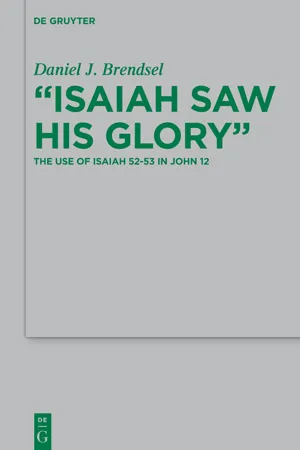1.1.1 Past Research
In 1954, David R. Griffiths made broad comparisons between Isaiah and John, rarely suggesting literary dependence. He concluded that a “more detailed comparison” between the two works would be “artificial and unconvincing.” Soon after, however, Franklin W. Young examined further correspondences between Isaiah and John, concluding that John “consciously utilized Isaiah as a source of language and ideology.” Young’s particular contribution lay in demonstrating that Isaiah speculation flourished in early Judaism.
In Günter Reim’s study of the OT background of John’s gospel, he identified over forty connections in John to Isaiah (ranging from quotations and allusions to “formal parallels”). For Reim, much of the Isaianic material in John derived from tradition (e. g., Synoptic tradition, wisdom traditions, a signs source), including all the quotations of Isaiah and several allusions to Isaiah (e.g., Isa 6:1; 11:2, 3 ff.; 42:1; 50:6; 53:7). Reim’s focus was drawn to clear Isaiah allusions and motifs having no traditional parallel (though even this material, Reim speculated, came to John through contact with other early Christians): the “light of the world,” the trial motif, the “glorifying” and “lifting up” of Jesus on the cross, and the “Lamb of God.” Many of these Isaianic allusions and motifs indicate that the figure of Isaiah’s Suffering Servant was of special concern for John (and the Christians with whom he was in contact). Reim’s brief survey is at times given to mere assertion without demonstration, and his source-critical assumptions and approach led him to pass too quickly over much important Isaianic material in John (e. g., the Isaiah quotations) in his evaluation of the function of Isaiah in the gospel. Nevertheless, Reim’s conclusion is noteworthy: “No book of the Old Testament has shaped the theology of John more than Deutero-Isaiah, and none of the authors of New Testament writings was influenced by Deutero-Isaiah as much as John.”
In 1982, Craig A. Evans proposed that John strategically places the twofold Isaiah quotation in 12:38–40 “to set the theological tempo for the passion narrative.” In a later article, Evans built on these findings, suggesting that John 12 is a “midrash” on Isa 52:7–53:12 and calling for a reassessment of the role of the Servant Songs in John’s gospel.
Focusing on issues of plot and intertextuality, Andrew T. Lincoln has suggested that the metaphor of lawsuit is one of “the most distinctive” characteristics of John’s gospel, “holding many elements of its plot and discourse together.” For Lincoln, “it is Isa 40 – 55 in particular that provides the resources” for the Johannine lawsuit motif and overall narrative form. John has reworked the lawsuit material in Isaiah 40 – 55 (i. e., the covenant lawsuit between Yahweh and Israel, and the trials and disputations between Yahweh and the nations) in his presentation of the trial of Jesus and the simultaneous counter-trial of the world by God.
In 1996, David Mark Ball argued that Jesus’ absolute “I am” sayings in John draw directly upon Yahweh’s
assertions in Isaiah 40 – 55. By asserting
, Jesus “takes on himself a phrase that is reserved for Yahweh alone and thus intimately identifies himself with God’s acts of creation and salvation.”
Ball also argued that “I am the light of the world” in John 8:12 (cf. 9:5) alludes to the promises of light for the
Gentiles in Isa 9:1, 2; 42:6; 49:6; 51:4, and “I am the way and the truth and the life” in John 14:6 draws upon the “way” motif in Isaiah 40 – 55.
These findings led Ball to conclude that Isaiah 40 – 55 “forms an essential foundation to understanding John’s whole picture of Jesus,” though further study is needed to determine the full extent of Isaianic influence on John.
Catrin H. Williams provided a complementary study to Ball’s, coming to similar conclusions concerning Isaianic influence on Johannine “I am” statements.
Williams further reflected on the use of Isaiah in John in two introductory essays, concluding that Isaiah holds “a prominent, if not the highest, position among the scriptural texts that have contributed to the shaping of John’s gospel.”
Most recently, James Hamilton offered a study proposing dozens of “resona-tio...



